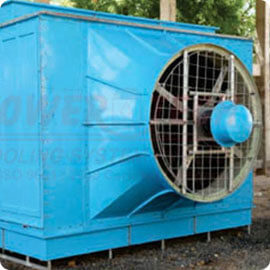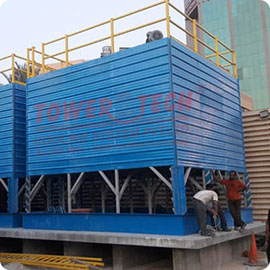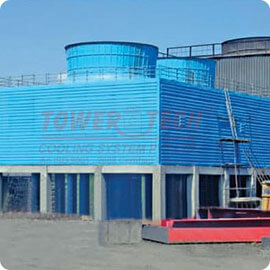
Cross Flow COOLING TOWER
Water travels vertically through the fill, while air flows sideways across the water via louvers in a crossflow cooling tower. The boiling water enters via gravity, while cold air crosses or rather rushes across the tower, coming into touch with the water and chilling it.
The air doesn’t need to enter through the supply system. It allows the hot water to pour into the basin positioned at the top of the column above the fill to use gravity. The water is enabled to stream in to balance the water in the basin as the drift exits through the top. The floating ball determines the precise level.
The cross-flow type of cooling tower is best suitable for every type of industry work. It can be easily adjusted because these towers are not very big. They can be easily modified according to the industry’s needs.
The CrossFlow Cooling Tower's Components
When building the cross flow cooling tower, various types of components are attached for completing the whole tower. These components must be extremely durable in order to survive the high levels of heat generated by the production facility.
There are various types of components available, and we have explained a bit about some of them over here:
- Spray nozzle: When water enters the area and fills it, it flows down via wideout apertures to the spray nozzles. They make it possible for the water to flow across a broad region.
- Basin: After the process of heat transfer from the hot water, the least over water is collected in the basin.
- Blade: A huge blade or fan is placed at the top of the tower, which supplies cool air in a downward direction.
- Air Inlet: The air enters the cooling tower through the air inlet.
- Louvers: It is the main component of the cooling tower as it keeps unwanted particles and birds from entering the cooling tower. It also helps in controlling water splashing.
- Drift Eliminator: Air passes through the louvers after the drift eliminator allows the evaporated water to let in.
The cross-flow cooling tower fills are located at a definite angle. The inclination angle of the fills can be easily adjusted according to the needs of our customers.
Fill, also known as wet deck surface, is a material used in cooling towers to enhance the structure’s contact area. A larger surface area provides far more interaction between the airflow and the water that results in faster evaporation.
Overview
Galvanized steel, stainless steel, glass fiber, and concrete are some of the most frequent materials utilized in the making of the tower. Plastics such as PVC and polypropylene are commonly utilized for filling. When water circumstances necessitate the use of splash fill, treated wood is still used today.
Crossflow cooling tower has a higher surface area so it is easy to physically maintain and inspect the tower. Towertech cooling tower crossflow fill supports are simple to install and blend well with existing cooling tower constructions.
Each component is designed to offer sufficient support while also improving product performance and enabling maximum air and water movement.




